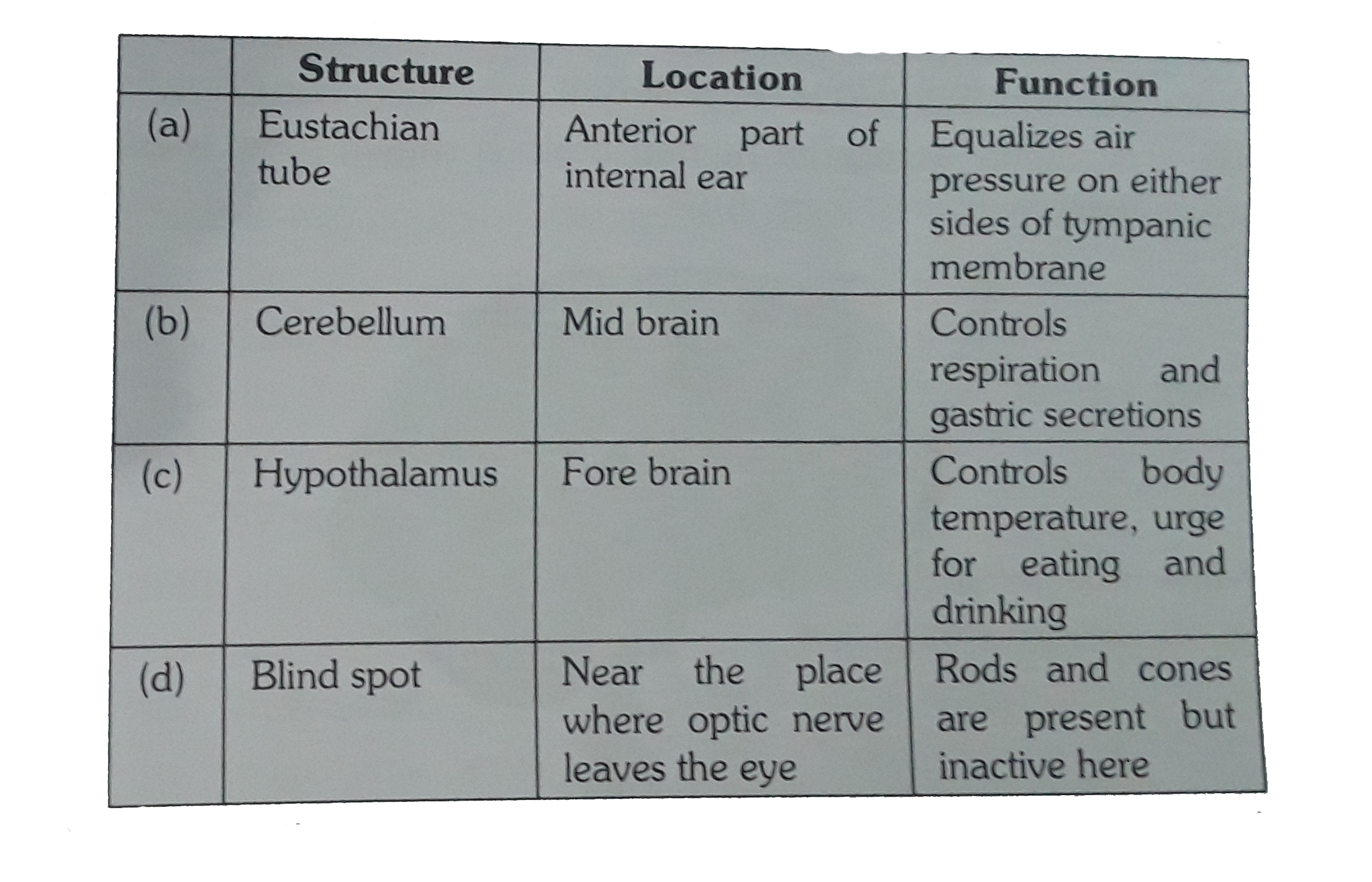Select the answer with correct matching of structures and their functions
Structure - Otolith organ, Function - Maintains the dynamic balance of body
Structure - Aqueduct of sylvius, Function - Connects the lateral ventricles with third ventricle brain
Structure - Bowman's glands, Function - Secrete mucus which spreads over the olfactory epithelium to keep it moist and traps dust etc
Structure - Merkel's discs, Function - Respond to pressure changes in dermis
To solve the question of matching structures with their functions, we will analyze each option provided and determine if the matches are correct.
1. Understanding the Question: We need to identify which option correctly matches a biological structure with its corresponding function.
2. Analyzing the First Option:
- Structure: Autolith Organ
- Function: Maintain the dynamic balance of the body.
- Evaluation: This option is correct. The autolith organs (otoliths) are involved in maintaining balance by responding to gravitational forces.
3. Analyzing the Second Option:
- Structure: Macroduct of Salvius
- Function: Connects lateral ventricle with the third ventricle of the brain.
- Evaluation: This option is incorrect. The Macroduct of Salvius actually connects the third ventricle with the fourth ventricle, not the lateral ventricle.
4. Analyzing the Third Option:
- Structure: Vermen's gland
- Function: Secretes mucus which spreads over the olfactory epithelium to trap dust.
- Evaluation: This option is also incorrect. The secretion of mucus in the nasal cavity is primarily done by seromucous glands, not specifically by Vermen's gland.
5. Analyzing the Fourth Option:
- Structure: Merkel's disc
- Function: Respond to pressure changes in the dermis.
- Evaluation: This option is incorrect. Merkel's discs are mechanoreceptors that primarily detect touch and pressure, not just pressure changes.
6. Conclusion: After evaluating all options, the first option is the only one that correctly matches a structure with its function.
Final Answer:
The correct answer is the first option: Autolith Organ - Maintain the dynamic balance of the body.
---
- Structure: Autolith Organ
- Function: Maintain the dynamic balance of the body.
- Evaluation: This option is correct. The autolith organs (otoliths) are involved in maintaining balance by responding to gravitational forces.
- Structure: Macroduct of Salvius
- Function: Connects lateral ventricle with the third ventricle of the brain.
- Evaluation: This option is incorrect. The Macroduct of Salvius actually connects the third ventricle with the fourth ventricle, not the lateral ventricle.
- Structure: Vermen's gland
- Function: Secretes mucus which spreads over the olfactory epithelium to trap dust.
- Evaluation: This option is also incorrect. The secretion of mucus in the nasal cavity is primarily done by seromucous glands, not specifically by Vermen's gland.
- Structure: Merkel's disc
- Function: Respond to pressure changes in the dermis.
- Evaluation: This option is incorrect. Merkel's discs are mechanoreceptors that primarily detect touch and pressure, not just pressure changes.
The correct answer is the first option: Autolith Organ - Maintain the dynamic balance of the body.
Topper's Solved these Questions
Similar Questions
Knowledge Check
Select the answer with correct matching of the structure, its location and function:
 AStructureLocationFunctionEustachian tubeAnterior part of internal earEqualises air pressure on either sides of tympanic membraneBStructureLocationFunctionCerebellumMidbrainControls respiration and gastric secretionsCStructureLocationFunctionHypothalamusForebrainControls body temperature, urge for eating and drinkingDStructureLocationFunctionBlind spotNear the place where optic nerve leaves the eye Rods and cones are present but inactive here
AStructureLocationFunctionEustachian tubeAnterior part of internal earEqualises air pressure on either sides of tympanic membraneBStructureLocationFunctionCerebellumMidbrainControls respiration and gastric secretionsCStructureLocationFunctionHypothalamusForebrainControls body temperature, urge for eating and drinkingDStructureLocationFunctionBlind spotNear the place where optic nerve leaves the eye Rods and cones are present but inactive hereSelect the answer with correct matching of the structure, its location and function
 AStructureLocationFunctionEustachian tubeAnterior part of internal earEqualises air pressure on either sides of tympanic membraneBStructureLocationFunctionCerebellumMidbrainControls respiration and gastric secretionsCStructureLocationFunctionHypothalamusForebrainControls body temperature, urge for eating and drinkingDStructureLocationFunctionBlind spotNear the place where optic nerve leaves the eye Rods and cones are present but inactive here
AStructureLocationFunctionEustachian tubeAnterior part of internal earEqualises air pressure on either sides of tympanic membraneBStructureLocationFunctionCerebellumMidbrainControls respiration and gastric secretionsCStructureLocationFunctionHypothalamusForebrainControls body temperature, urge for eating and drinkingDStructureLocationFunctionBlind spotNear the place where optic nerve leaves the eye Rods and cones are present but inactive hereSelect the answer with correct matching of the stucture its location and function
AStructureLocatonFunctionEustachianAnterior part of internal earEqualises air pressure on either sides of tympanic membraneBStructureLocatonFunctionCerebellumMidbrainControls respiration adn gastric secretionsCStructureLocatonFunctionHypothalamusForebrainControls body temperature, urge for eating and drinkingDStructureLocatonFunctionBlind spotNear the place where optic nerve leaves the eyeRods and cones are present but inactive here
